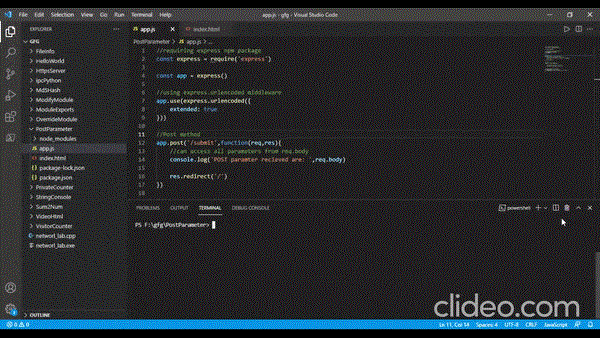Express.js 如何接收post参数
Express是一个小型框架,坐落在Node.js的Web服务器功能之上,简化了其API并添加了有用的新功能。通过中间件和路由,它可以更容易地组织应用程序的功能;它为Node.js的HTTP对象添加了一些有用的工具;它便于渲染动态HTTP对象。Express.js提供了各种处理不同类型的传入请求(如get、post等)的方法。在本文中,我们将讨论如何在express.js中接收post参数。
POST参数 可以使用 express.urlencoded() 中间件和 req.body 对象从表单接收。express.urlencoded()中间件有助于解析来自客户端的数据。
语法:
express.urlencoded( [options] )
参数: options参数包含了各种属性,如extended、inflate、limit、verify等等。
返回值: 它返回一个对象。
示例: 让我们逐步讨论如何在express.js中接收POST参数。
步骤1: 创建一个“ app.js ”文件,并使用npm初始化您的项目。
npm init
步骤2: 创建一个名为“ index.html ”的文件,并使用npm安装 express 包。
npm install express
项目结构:
步骤3: 现在让我们首先编写“ index.html ”文件。在该文件中,我们创建一个表单,将该表单以 method 为“ POST ”提交到稍后在“ app.js ”文件中声明的“ /submit ”路由上。
index.html
<!DOCTYPE html>
<html lang="en">
<head>
<meta charset="UTF-8">
<meta http-equiv="X-UA-Compatible"
content="IE=edge">
<meta name="viewport" content=
"width=device-width, initial-scale=1.0">
</head>
<body>
<!-- Action to the same route as in app.post() method -->
<form action="/submit" method="post">
Name: <input type="text" name="name">
<br><br>
Email: <input type="email" name="email">
<br><br>
Gender: <br> <input type="radio" name="gender" id="male">
Male
<br>
<input type="radio" name="gender" id="female">
Female
<br>
<input type="radio" name="gender" id="private">
Don't want to disclose
<br><br>
Hobbies: <br> <input type="checkbox"
name="painting" id="painting">
Painting
<br>
<input type="checkbox" name="dancing" id="dancing">
Dancing
<br>
<input type="checkbox" name="singing" id="singing">
Singing
<br> <br>
<input type="file" name="file" id="">
<br> <br>
<button type="submit">Submit</button>
</form>
</body>
</html>
步骤4:
- 现在在 app.js 文件中,我们将定义根目录的 GET 请求。对于 GET 请求,我们将“ index.html ”文件发送给客户端。
- 对于“‘ / submit ’” POST 请求,我们从表单中获取输入,并将其打印到控制台上 req.body 。req.body是一个包含表单所有属性的对象。我们可以使用 **req.body.
** 访问任何属性。例如:在这种情况下,使用req.body.name。
app.js
// Requiring express npm package
const express = require('express')
const app = express()
// Using express.urlencoded middleware
app.use(express.urlencoded({
extended: true
}))
// Handling Post request
app.post('/submit',function(req,res){
// Can access all parameters from req.body
console.log('POST parameter received are: ',req.body)
res.redirect('/')
})
// Get request
app.get('/',function(req,res){
// Sent index.html file to the client
res.sendFile(__dirname+'/index.html')
})
// Creating server at port 3000
app.listen(3000,function(req,res){
console.log('started listening at server 3000')
})
步骤5: 使用以下命令运行 app.js 文件:
node app.js
步骤6 。在任何浏览器中输入本地服务器地址。
http://localhost:3000/
输出: 因此,通过这种方式我们可以在express.js中接收POST参数。

 极客教程
极客教程